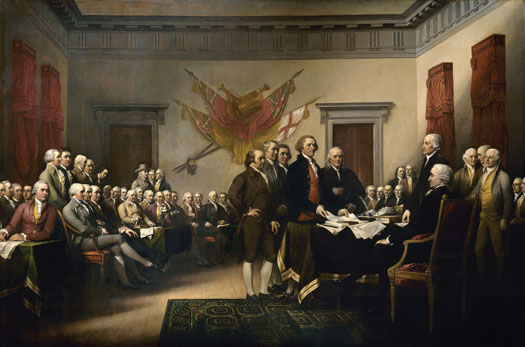| << Chapter < Page | Chapter >> Page > |
The first such tax to draw the ire of colonists was the Stamp Act , passed in 1765, which required that almost all paper goods, such as diplomas, land deeds, contracts, and newspapers, have revenue stamps placed on them. The outcry was so great that the new tax was quickly withdrawn, but its repeal was soon followed by a series of other tax acts, such as the Townshend Acts (1767), which imposed taxes on many everyday objects such as glass, tea, and paint.
The taxes imposed by the Townshend Acts were as poorly received by the colonists as the Stamp Act had been. The Massachusetts legislature sent a petition to the king asking for relief from the taxes and requested that other colonies join in a boycott of British manufactured goods. British officials threatened to suspend the legislatures of colonies that engaged in a boycott and, in response to a request for help from Boston’s customs collector, sent a warship to the city in 1768. A few months later, British troops arrived, and on the evening of March 5, 1770, an altercation erupted outside the customs house. Shots rang out as the soldiers fired into the crowd ( [link] ). Several people were hit; three died immediately. Britain had taxed the colonists without their consent. Now, British soldiers had taken colonists’ lives.

Following this event, later known as the Boston Massacre, resistance to British rule grew, especially in the colony of Massachusetts. In December 1773, a group of Boston men boarded a ship in Boston harbor and threw its cargo of tea, owned by the British East India Company, into the water to protest British policies, including the granting of a monopoly on tea to the British East India Company, which many colonial merchants resented.

In the early months of 1774, Parliament responded to this latest act of colonial defiance by passing a series of laws called the Coercive Acts , intended to punish Boston for leading resistance to British rule and to restore order in the colonies. These acts virtually abolished town meetings in Massachusetts and otherwise interfered with the colony’s ability to govern itself. This assault on Massachusetts and its economy enraged people throughout the colonies, and delegates from all the colonies except Georgia formed the First Continental Congress to create a unified opposition to Great Britain. Among other things, members of the institution developed a declaration of rights and grievances.
In May 1775, delegates met again in the Second Continental Congress . By this time, war with Great Britain had already begun, following skirmishes between colonial militiamen and British troops at Lexington and Concord, Massachusetts. Congress drafted a Declaration of Causes explaining the colonies’ reasons for rebellion. On July 2, 1776, Congress declared American independence from Britain and two days later signed the Declaration of Independence .
Drafted by Thomas Jefferson , the Declaration of Independence officially proclaimed the colonies’ separation from Britain. In it, Jefferson eloquently laid out the reasons for rebellion. God, he wrote, had given everyone the rights of life, liberty, and the pursuit of happiness. People had created governments to protect these rights and consented to be governed by them so long as government functioned as intended. However, “whenever any Form of Government becomes destructive of these ends, it is the Right of the People to alter or to abolish it, and to institute new Government.” Britain had deprived the colonists of their rights. The king had “establish[ed] . . . an absolute Tyranny over these States.” Just as their English forebears had removed King James II from the throne in 1689, the colonists now wished to establish a new rule.
Jefferson then proceeded to list the many ways in which the British monarch had abused his power and failed in his duties to his subjects. The king, Jefferson charged, had taxed the colonists without the consent of their elected representatives, interfered with their trade, denied them the right to trial by jury, and deprived them of their right to self-government. Such intrusions on their rights could not be tolerated. With their signing of the Declaration of Independence ( [link] ), the founders of the United States committed themselves to the creation of a new kind of government.

Thomas Jefferson explains in the Declaration of Independence why many colonists felt the need to form a new nation. His evocation of the natural rights of man and his list of grievances against the king also served as the model for the Declaration of Sentiments that was written in 1848 in favor of giving women in the United States rights equal to those of men. View both documents and compare.
For many years the British colonists in North America had peacefully accepted rule by the king and Parliament. They were proud to be Englishmen. Much of their pride, however, stemmed from their belief that they were heirs to a tradition of limited government and royal acknowledgement of the rights of their subjects.
Colonists’ pride in their English liberties gave way to dismay when they perceived that these liberties were being abused. People had come to regard life, liberty, and property not as gifts from the monarch but as natural rights no government could take away. A chain of incidents—the Proclamation of 1763, the trial of smugglers in courts without juries, the imposition of taxes without the colonists’ consent, and the attempted interference with self-government in the colonies—convinced many colonists that the social contract between the British government and its citizens had been broken. In 1776, the Second Continental Congress declared American independence from Great Britain.

Notification Switch
Would you like to follow the 'American government' conversation and receive update notifications?